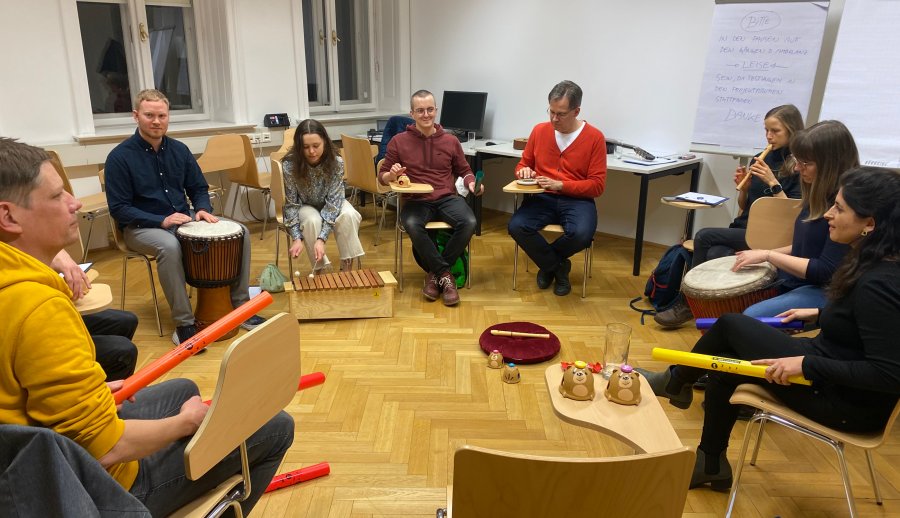What is the research project about?
M4A is a research project that evaluated the effects of music therapy compared to a play-based intervention to improve social communication, participation, mental health, and brain functioning in autistic children aged 6 to 12 years. It was designed to provide strong evidence of clinical effects and working mechanisms of music therapy, and will contribute to a better understanding of autism and neuroplasticity.
Project information
Project start: May 2021.
Recruitment completed.
Last follow-up completed: December 2024.
Trial registration:
at clinicaltrials.gov: NCT04936048

Background
The notion of a connection between autism spectrum disorder (ASD) and music is as old as the first reported cases of autism, and music has been used as a therapeutic tool for many decades. Music therapy (MT) has shown promising results for children's social communication, parent-child relationships, quality of life and participation in family life. However, to predict outcomes more accurately, a better understanding of the working mechanisms, or how MT is leading to positive outcomes in autistic children is needed.
Therefore, the ongoing Music for Autism (M4A) trial aimed to evaluate the effects of 12 weeks of MT compared to 12 weeks of a matched play-based therapy intervention on a group of autistic children aged 6-12 years. The children for the study were recruited in Vienna, Austria, and Bergen, Norway.
Outcomes
Before and after each intervention, children were assessed for several neurobehavioral and biological outcomes including social communication skills, participation, family quality of life, mental health, brain connectivity, brain structure, gut microbiome, and stress levels.
For the full list of primary and secondary outcome measures, see the study's trial registration page at ClinicalTrials.gov.
Method
M4A was designed as an assessor blinded crossover RCT, comparing music therapy (MT) to a structurally matched play-based intervention (PBI). Following the baseline assessment, a concealed random allocation to a sequence of interventions (MT-PBI or PBI-MT) was implemented by one researcher who did not have contact with participants. Each intervention had a duration of 3 months and included a 3 month washout period between interventions.
Both interventions consisted of 12 weekly one-on-one sessions, 45 minutes each, conducted in the same setting by a licensed music therapist, in accordance with an intervention manual developed for the study. Using a theoretically motivated approach, both interventions targeted similar domains such as creating a shared experience, building meaningful relationships, and fostering self-expression. A varied set of activities combining therapist- and child-led interactions targeted common goals, such as multisensory integration, verbal and social communication, emotion regulation, turn-taking, social appropriateness, and interaction. During both interventions, children could choose 4 activities per session using a visual schedule to facilitate their choices and as a visual support throughout the therapy. While both therapies targeted the same aforementioned goals, music therapy did so through the use of rhythmic cues, music instruments (e.g., piano, drums, djembe, xylophone, harmonica), songs, and stories accompanied by songs or musical instruments, and the play-based intervention used verbal interaction, toys (e.g., building bricks, finger puppets, Play-Doh, puzzles), and the same stories as in music therapy, but without a musical component.
Work packages
WP1: Recruitment and randomisation
WP2: Clinical assessments and brain imaging
WP3: Interventions
WP4: Statistical analyses and reporting
WP5: Microbiome
WP6: Behavioural tasks
The research Project
will contribute to a better understanding of autism and neuroplasticity.
International project team
M4A is a randomised controlled trial conducted in Norway and Austria. It was led by NORCE Norwegian Research Centre (PI Christian Gold) and conducted in collaboration with the University of Bergen (Co-PI Karsten Specht) and the University of Vienna (Co-PI Giorgia Silani).
See the country-specific pages for more information about the Norwegian project team and the Austrian project team.
Master students in both countries assisted with data collection, interventions, and scanning while conducting smaller sub-projects linked to M4A. Therapists and clinical psychologists worked within the project on an hourly basis.
Monitoring Committee
The role of the DSMC was to safeguard the interests of trial participants, assess the safety of the interventions during the trial, and monitor the overall conduct of the clinical trial. The DSMC monitored data quality, safety, ethical aspects, and that the study can be conducted sufficiently in terms of recruitment, data collection, problems at participating sites, differences between the groups, and missing data.
The independent DSMC consisted of three people with strong methodological and clinical expertise who are not otherwise affiliated with the project or its institutions:
- Mike Crawford (chair; Professor at Imperial College London, UK)
- Luise Poustka (Professor at the University of Göttingen, Germany)
- Paul Bassett (freelance statistician and owner of Statsconsultancy Ltd near London, UK)
- John Carpente (Professor at Molloy University, NY, US)
The DSMC had unblinded access to study data and received regular updates on recruitment, uptake of interventions, unforeseen events, adverse events, and immediate information on serious adverse events from the trial statistician (Jörg Assmus). Meetings with the DSMC were held on a biannual basis and consisted of an open and a closed part. If issues arose, the DSMC recommended to the PI on appropriate action.
Advisors
Aparna Nadig and Megha Sharda, who conducted the Canadian study M4A is based upon, have provided input on methodology and have agreed to act as scientific advisors. This ensures appropriate replication, including fidelity of interventions and reliability of assessments.
User representativesJonathan Gärtner, a young man with ASD who participated in MT for many years, and Helene Hodor, his relative who initiated his MT and other supporting activities, served as user representatives for M4A in Vienna; Kristin Whitehouse, the mother of an autistic child who participated in the study, serves as a user representative in Bergen.
Before the project start, user representatives discussed the project; confirmed the relevance of the primary outcome; commented on the importance of secondary outcomes; and gave advice on the relevance of intervention elements. During the project, they continued to give advice to the project team in meetings (approx. twice a year) and as needed, and also helped with recruitment and dissemination through their existing networks.
